Explore Flutter Development: Your Source for Development Tips, Code, and Invaluable Insights
Don't wanna be here? Send us removal request.
Text
#Pharmacy app development#Healthcare app development#Prescription management app#Medication reminder app#AI in pharmacy apps#Prescription app development#Online medicine delivery app#Medical app features and cost#Digital healthcare solutions#Build pharmacy app like Walgreens
0 notes
Text
#Meditation App Development#Build App Like Calm#Flutter App Development#Mental Health Tech#Mobile App Startup#meditation app
0 notes
Text
Is a Pharmacy App Like Walgreens on Your Mind? Discover the Features & Cost!
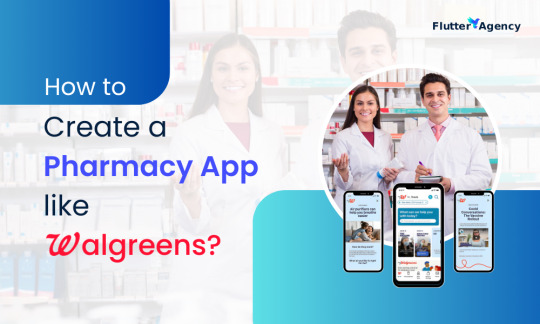
There has been a paradigm shift in the pharmacy industry with the impact of digital innovations and changing expectations of consumers, and a host of things have transformed. Most people want the convenience of ordering medicines, refilling prescriptions, and consulting with practitioners virtually. This has led to a huge demand for pharmacy apps with plenty of features that ease accessing healthcare services.
Walgreens’ pharmacy application is one such app that has established truly high standards for seamless prescription management, medication reminders, and expanded telehealth features. Partnering with a development firm will allow you to develop an app like Walgreens with a user-friendly, secure, and scalable app that employs the latest technology and strict regulatory compliance.
By 2028, the global pharmacy market is expected to reach $206 billion. The global stats state that 60% of consumers prefer mobile applications for managing their prescriptions. Walgreens, CVS, and other top players generate millions in revenue through their applications.
Flutter Agency offers pharmacy app development to empower businesses to create robust and intuitive applications that meet the needs of modern healthcare. Whether you are a startup or own a pharmacy chain, we ensure custom solutions that help you build a successful digital healthcare platform.
Why Develop a Pharmacy App Like Walgreens?
When you connect with our mobile application development agency for pharmacy apps like Walgreens development, they do look into the key features of the application to include in your app. Some of the key points our experts try to adapt are:
1. Convenience Drives Customer Loyalty
Most users prefer ordering medications, refilling prescriptions, and consulting doctors from the application, and Walgreens allows users to enjoy this from the comforts of their homes. Such applications eliminate long wait times and provide seamless access to healthcare services.
2. Enhancement in Business
The industry is evolving with applications that are packed that allow pharmacies, healthcare providers, and start-ups a one-stop solution to enter the markets. Our mobile app developers bring the most advanced technologies like AI-based suggestions, reminders of taking medications, and live tracking of orders and improve the user experience in so many other ways.
3. Sales and Customer Integration
To keep your growth on an uptick, we know that customer engagement with many sales strategies will make your business profitable. Enable customized push notifications for consumers that will keep them updated about the discounts, refill reminders, etc., to keep them engaged. Integration of a loyalty program is also something that will help you gain repeat trips from customers. Since the world is going cashless, it’s good to have online payment options and home delivery options to facilitate an easy buying process.
Here’s why your pharmacy store should go for digital transformation to take great strides ahead. To ensure your application contributes to your profits while incorporating certain interesting features.
Must-Have Features for a Walgreens-Like Pharmacy App
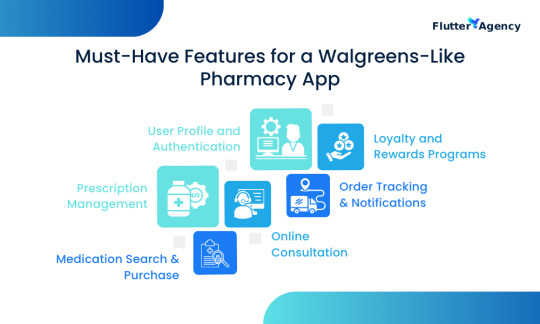
Flutter Agency is creating pharmacy apps with basic features to improve user experience, security, and access to health services. Some of the main functionalities that we integrate into the pharmacy app include:
1. User Profile and Authentication
As your e-pharmacy will be dealing with your private and likely sensitive details, a secured login should be offered either by email, number or through biometrics: fingerprint or Face ID. We ensure profile management with elements like storing medical history, prescriptions, and payment details.
2. Prescription Management
With the ease of uploading your paper prescriptions and integrations, we ensure that the application you are taking to the market allows sharing e-prescriptions over the encrypted channel. With auto-refill reminders, we make sure your audience never misses their medications and continues leading a healthy life.
3. Medication Search & Purchase
You can easily upload a user-friendly catalog that includes smart filters and drug information on the application without much hustle. We allow AI-powered recommendations that are based on user history, previous preferences, and medical history.
4. Online Consultation (Telehealth Integration)
Our mobile app development team allows patients to virtually visit doctors for consultations, revise prescriptions, and get approvals. We allow secure video calls and in-app chat for clear communication and better understanding.
5. Order Tracking & Notifications
With real-time order tracking of orders, users can check when they can get their medicines delivered. With instant push notifications for order confirmation, dispatch, and arrival updates. This helps you build a solution that keeps your users engaged with the application.
6. Loyalty and Rewards Programs
We understand how amazing exclusive discounts, cashback, and reward points may seem to your audience. With our technology-backed solutions, you can offer personalized offers on purchase history and user preferences.
Advanced Features to Elevate Your Pharmacy App

To ensure the solution we develop stands out in the competitive pharmacy app market, we integrate advanced features that can enhance user experience and drive business growth. Some of the best features that one would like to add are:
1. AI-Driven Drug Recommendations
Your users may not want to consult a health practitioner for a cold or cough. The solution can provide personalized medication suggestions based on the user’s medical history and preferences. With AI-driven alerts for drug reactions, reminders, and alternative options, we create a solution that is designed for modern-day users.
2. Chatbots for 24/7 Customer Support
With constant AI-powered assistance for prescription inquiries, order tracking, and FAQs, we make sure your customers don’t have to wait for hours before they get the right assistance. With generative AI chatbots, your app responds in a way that is best suited to meet user demands.
3. Integration with wearable devices.
We do know the use of wearable technology in the healthcare sector. We make sure that users can sync their smartwatches and fitness trackers to receive heart rate, blood pressure, and medication compliance reports.
4. Voice Search & Smart Assistants
With hands-free navigation, we perform medication searches and prescription refills using voice commands. It is quite good for the users who find it hard to operate the app. You can ask our developers to make your solutions compatible with Alexa, Google Assistant, and Siri for full accessibility.
5. Data Analytics Insights
Managing and monitoring health is a necessity. The user can check their reports and other test results with a click. If you are a business owner, you can get real-time reports on sales, user behavior, and inventory. Thus, you can reduce human intervention in your work to ensure your customers never face any problems.
Cost of Developing a Pharmacy App Like Walgreens
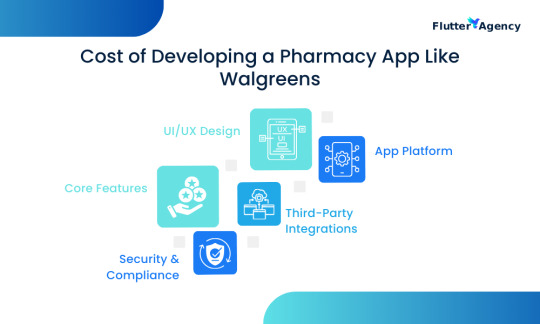
The cost of developing any pharmacy app will depend on factors like design, features, security, integrations, etc. Here is how the mainstream breakdown of key cost drivers may look:
1. UI/UX Design
For any application to work well enough and bring good results, first and foremost, it has to have a simple interface that will allow user engagement and ease of interaction. A pharmacy application must have custom design elements and a user-friendly layout to reflect its purpose and services. The expert design work and intricacies in navigation may add to the development cost.
2. Core Features
If you need a pharmacy application with basic features like prescription management, user dashboard, order tracking, etc, the cost of development is quite low. If you want to integrate advanced features like AI-backed recommendations, telehealth integrations, and smart search facilities may add to the development expense of the pharmacy app.
At Flutter Agency, we help you decide the best features that meet your business purpose and vision to ensure the development happens within the financial constraints.
3. Security Compliance
To ensure the security and privacy of the data stored in your pharmacy application, we implement advanced secure data encryption, multi-factor authentication, and fraud prevention that adds to the time and cost of development.
4. Third-Party Integrations
Depending on your business needs, we’d have to integrate a few third-party APIs like payment gateway, e-prescription system, wearable device, etc. The licensing of these APIs can add to the extended cost of pharmacy app development.
5. App Platform
Native app development may offer uninterrupted and flawless performance but would cost more. With hybrid or cross-platform app development, you can save some buck, but it won’t be as seamless as the native apps.
The developers partnered with us can create scalable and budget-friendly pharmacy applications without taking a chance on quality, security, or compliance. We offer custom solutions that reflect your business objective and vision!
Monetization Strategies: How to Maximize ROI
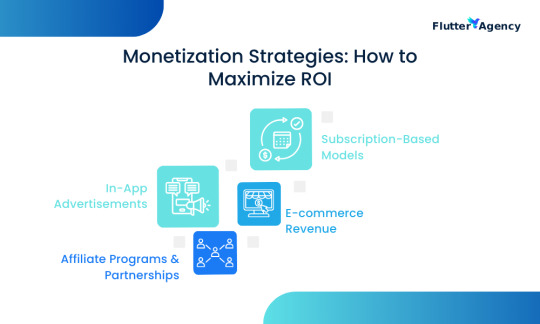
If you want to enter the market with a pharmacy app like Walgreens, you need to understand it is about convenience and revenue amalgamated. To ensure you get the best out of your investment in your application, we share here some of the monetization strategies you may choose from:
1. Subscription-Based Models
You can let users have premium memberships with extended benefits like priority delivery, virtual doctor consultations, discounts, etc. You can always encourage your audience to subscribe with free trials and loyalty perks.
2. In-App Advertisements
Partner with top pharmaceutical brands to display targeted ads for medications, supplements, and healthcare products. This would help you earn some extra revenue and take these brands to your users.
3. E-commerce Revenue
With the app, you make a good profit selling medications, wellness products, supplements, and other health products. Include in your application some package deals, flash sales, and personalized recommendations to keep the app user engaged.
4. Affiliate Programs & Partnerships
Partnering with clinics, labs, and insurance providers to share their services can get you a good profit for referral commission. You can share links to lab test bookings, insurance plans, or further specialists with your users through the app, ensuring them you care.
Regulatory Compliance & Security Considerations
When working on an app like Walgreens, there are a few things that can’t be ignored. Data security and regulatory compliance hold the foundation of such applications as what you deal with is personal health information and other personal details. Some of the common compliances to stick to are:
The Health Insurance Portability and Accountability Act (HIPAA) in the U.S. is designed to protect patient data.
General Data Protection Regulation (GDPR) ensures data privacy for European users.
PCI-DSS-compliant payment gateways ensure safe online transactions.
Use AI-powered fraud detection to prevent suspicious activities.
If you want to target a global market, you need to adhere to these compliances. Along with this, you’d need secure server services, the right encryption, and role-based access control to ensure user data is managed in a safe environment.

At Flutter Agency, we have experience and expertise in building pharmacy applications, and we understand the significance of implementing regulatory compliance and data security in pharmacy applications. We create solutions that abide by HIPAA, GDPR, and PCI-DSS standards to ensure data integrity, encrypted transactions, and user privacy.
Also Read: How to Make a Meditation Application Like Calm
Let’s Build Your Pharmacy App Today!
Convenience, accessibility, and digital healthcare solutions are among the leading reasons for the boom in demand for pharmacy apps like Walgreens. Companies with a focus on developing high-end, feature-rich pharmacy apps can find a flourishing market, with all the resurrection of client satisfaction and cash flows swelling up.
We exceed the standards in custom pharmacy app development by doing everything to satisfy HIPAA, GDPR, and various other regulations while integrating state-of-the-art tech for amplified functionalities. Be it a startup nurture or something like a 200-year-old pharmacy chain, our tailor-made solutions will always keep you ahead in this digital health revolution.
Is your pharmacy app concept ready for shake-up? Contact us today via a free consultation, and let’s get started with your next-gen pharmacy app!
#Pharmacy App Development#Healthcare App Solutions#Build App Like Walgreens#Flutter for Healthcare Apps#Custom Medical App Development#Pharmacy app development#Walgreens app features#Healthcare app development#Medication reminder app#AI in pharmacy apps
0 notes
Text
How to Make a Meditation Application Like Calm

Stress can be defined as an emotional or psychological discomfort your body experiences when faced with a challenge. Whether you are a student or a working professional, everyone experiences a certain level of stress in day-to-day lives.
However, we understand if you find this task a little complicated — many people do. In that case, you can always hire a Flutter developer to build a meditation application like Clam.
While stress can be beneficial because it can motivate and improve a person, too much can take a huge toll on physical and mental health. And, in this fast moving world, it is not uncommon to see people going through extreme stress due to professional or personal reasons. This is why meditation apps like Calm are gaining huge popularity. According to Business of Apps, Calm has over 100 million downloads globally.
Given the pace at which we are moving forward, this number is expected to increase in the near future.
Therefore, making a meditation app like Calm would be a great idea. It is a simple and easy solution with very high potential. If you are unsure about how to go forward with this, don’t worry — we will walk you through the journey with practical insights and tips.
Tips to Build a Meditation Application like Clam

1. Understanding User Needs
If you are planning to make an app, the first thing you should think about is your target audience. In most cases, people download meditation apps to either escape stress or improve focus. So, ask yourself — why would a user download your app?
For instance, users who want a quick 5-minute meditation session during work breaks need certain features that might not be useful to users looking for longer sessions before sleep. So, always design your content and features around your users�� behaviors.
But your estimates might not be accurate at all times. If you really want to understand them, you should hear it directly from them. So, your app should always have an easy feedback mechanism, like ratings or comments. As you will continue to collect this data, you can implement the necessary changes to make it more useful and user-friendly.
You must also pay attention to the technical side. Use tools like Firebase Analytics or Amplitude to track data. You can find information about what content resonates most and where users spend their time. This real-time data will let you adjust content and offer more personalized suggestions.
2. Creating A Relaxing and Intuitive Interface
The design of your app is not just about looking pretty — it directly impacts how users feel when they open it. Think of it this way: every interaction they have with your app should lower stress, not add to it. You will have to pay attention to even the smallest details for this.
For instance, did you know that colors can influence your mood and stress level? Research shows that certain colors evoke calmness — muted blues, greens, light pastels, etc. because they are soothing. So, try to stick to similar colors.
Also, the UI should be clean and easy to navigate. If you add too many unnecessary elements to the screen, it will make it appear disorganized and also add to the stress level. As a golden rule, make sure that every element on the screen has a purpose.
Clear calls to action also help, like “Start Meditation” or “Play Sound”.
3. Seamless Audio is Important
Here is where it gets technical. Meditation apps are nothing without excellent audio. You need smooth and uninterrupted playback whether the user is listening to a guided session or ambient sounds.
While users expect high-quality audio, high-quality files can slow down the app or take up too much space. You will have to compress them properly. File formats like AAC or OGG are for better compression without sacrificing audio quality. For large sound libraries, you can host files on AWS S3 or Cloudinar — content delivery networks (CDNs) can be used to reduce loading time.
Another choice you will need to make is whether users stream or download the content. Streaming saves space but requires constant internet access, while downloaded content can take up significant storage.
Our advice? Offer both. Let users download their favorite tracks and sessions, but stream everything else by default. You can easily enable offline access using SQLite databases or Secure Storage in mobile development frameworks.
Pro Tip: Integrate audio libraries like ExoPlayer (Android) or AVFoundation (iOS) for better audio handling.
4. Smart Personalization
One feature that makes Calm so addictive is how personal it feels. The app remembers what you listened to, suggests content based on your mood, and tracks your progress.
Let us break down how you can implement these features in a practical way.
Tracking Progress and Streaks
User Profiles: Store users’ meditation history, session streaks, and achievements on the backend. For cloud sync, use Firebase Authentication to ensure users can access their data across devices.
Progress Visuals: Simple things like a visual streak counter or a daily meditation goal help in user retention. You can display this data in progress bars or charts. They are relatively easy to implement using libraries like React Native Chart Kit or MPAndroidChart.
AI-powered recommendations are also an essential feature today. When a user opens the app, you want to greet them with suggestions that feel custom-made for them. You can achieve this through a recommendation engine — a simple approach that would be using collaborative filtering algorithms. For example, if two users follow a similar pattern, suggest to one what the other has enjoyed.
You can also use TensorFlow Lite to integrate machine learning into your app. This will make your app more sophisticated because it will analyze user behaviors and provide real-time recommendations.
5. Monetization
Nobody likes a hard sell, especially in a meditation app. Calm’s approach to monetization is subtle — you offer value upfront, then gradually invite users to unlock premium features.
Freemium Model
Start with a base free version of your app. Offer enough content to make it valuable but leave your best content behind a paywall. This could include:
Exclusive sleep stories
Advanced guided meditations
Special soundscapes for deep relaxation
Subscription tiers
You might offer a monthly, yearly, and lifetime subscription. In our experience, users tend to prefer yearly subscriptions over monthly, as they provide more value for long-term commitment.
In-app Purchases
If you opt for one-time purchases, keep the price of individual items low. Something like $0.99 for a new meditation pack feels approachable.
Just ensure that you integrate payment gateways such as Stripe or Apple Pay for quick and secure transactions. Also, your app should be compliant with PCI-DSS standards for safe payments.
6. Choosing the Right Tech Stack
While front-end design and user experience are important, the tech stack you choose will dictate how well your app performs. From our experience, here is what we recommend:
Cross-Platform Development
For a seamless experience across iOS and Android, choose a framework that allows you to write one codebase for both platforms. Flutter offers great control over animations and performance if you are targeting both platforms with native experiences. Additionally, you can consider React Native because of its vast ecosystem and flexibility.
Backend Infrastructure
Node.js with Express: This is perfect for building a scalable API that handles your users, sessions, and audio files.
Database: Use Firebase Realtime Database or MongoDB Atlas for quick data storage.
Deployment and Scalability
Docker is great to ensure smooth deployment and scalability as your app grows. It simplifies the process of deploying updates and makes scaling your infrastructure easier.
7. Testing and Launching
This is the final step in the process of developing an app.
Perform a thorough manual testing to check that all the elements are responding correctly.
Also, you have to perform automated testing to check for bugs. Both Jest or Appium are good options for mobile testing automation.
If everything seems fine during the testing stage, it is time to launch the app. Release it on App Store and Google Play.
Wrapping Up
This blog clearly explains how you can develop a mediation app. You can follow our steps to build your own meditation app.
Flutter Agency is a reputed name in the industry that you can hire to build apps. From conceptualizing to deploying the app, we will help throughout the process.
To contact our team, you can call +91 7777 965000 in India and +1 850 780 1313 in the US. We are always available to assist you in designing the best meditation apps like Calm.
#Meditation App Development#Build App Like Calm#Flutter App Development#Mental Health Tech#Mobile App Startup
0 notes
Text
#Best App Development Firms#Build a Food Delivery App#Food Delivery Service App#Build a Food Sharing App like ChowNow#Building a food delivery app like ChowNow#food delivery service platforms#food delivery apps
0 notes
Text
Are You Interested In Creating A Food Sharing App Like ChowNow?

Do you know that ChowNow generates a revenue of $42 to $93 million annually?
Restaurants in the US and Canada are readily choosing ChowNow over other food delivery apps. The reason is quite simple—fewer commissions, which means more revenue for the restaurant businesses. The popularity of ChowNow has encouraged other entrepreneurs to hire the best app development firms and build a similar food delivery app.
However, before you set your mind on building a similar food app, you should do an in-depth analysis of ChowNow. What are its key features? How does it generate revenue? How is ChowNow different from others? Why are restaurants choosing ChowNow? What is their USP and how is it attracting restaurant owners?
This blog does a rigorous audit of ChowNow’s business model so that you get clarity on how this app functions. This knowledge will help you formulate a roadmap for building an app like ChowNow and help you plan its value proposition, user acquisition, app functionalities, and, most importantly, how to capture the competitive market of food delivery apps.
What Is the ChowNow App?
ChowNow is a food delivery platform that enables restaurants to build their custom food ordering system. However, its business model is different from other food apps on the market, which is its USP.
From the customer’s perspective, you use ChowNow as you use UberEats or DoorDash. But when you get into the restaurant’s perspective, several things change for the better.
Firstly, ChowNow doesn’t charge commissions from restaurants like other apps. Usually, apps charge 20% to 40% commissions from restaurants, which puts a heavy toll on their revenue. However, ChowNow employs a subscription-based model where restaurants pay a certain amount monthly or annually for using ChowNow services. This puts more money into the restaurant owners’ pockets and supports their growth.
Secondly, ChowNow doesn’t have its delivery drivers, as it is not exactly a food delivery service app. What you need to understand about ChowNow is that it’s more like a middleman that helps restaurants with tools and tech stack for setting up their food ordering system.
Restaurants can customize their food ordering interface with POS integrations, centralized menu management, and website ordering. They can hire their delivery drivers and tailor the ordering system as per their requirements. Plus, it also enables restaurants to build their branded app and restaurant website, helping them attract, convert, and retain customers. Restaurants can even run and track their marketing campaigns from the ChowNow platform.
ChowNow saves restaurants from juggling between different food delivery apps and their high fees. It gives them the flexibility to build their ordering app, enhance their brand positioning, market effectively, and increase revenue substantially.
What Is The Value Proposition Of ChowNow?

Commission-free business model: Unlike popular apps, ChowNow doesn’t charge heavy commissions on each order. Instead, they have a subscription model that enables restaurants to keep a larger part of their revenue.
Custom Branding: Restaurants can get a custom app and website that boosts their brand image and helps them offer personalized user experiences.
Integration Flexibility: Businesses can easily integrate their existing POS with the ChowNow platform, enabling them to manage orders and payments.
Marketing Support: The platform emphasizes strengthening local small restaurants by offering them marketing tools and support to attract an audience.
Key Features of a Food Delivery App Like ChowNow

Restaurant Management Dashboard
Order management: Offer restaurants tools to customize their food ordering system.
Menu management: Enables restaurants to optimize the menu by adding, removing, and updating menu items easily.
Delivery coordination: Hire delivery riders and coordinate and manage them effortlessly.
Analytics and reports: View sales reports, marketing performance, customer insights, feedback, inventory, and more on one dashboard.
Marketing monitoring: Track loyalty programs, monitor campaigns, and execute marketing strategies to attract and engage customers.
Order monitoring: Provides restaurants with an easy-to-use interface to track and manage all orders.
Payments and commissions: Receive payments from customers, manage platform commissions, and handle rider payments hassle-free.
Promotions: Plan, run, and track promotions and campaigns across the restaurant app and website.
Driver assignment: Automatically assign orders to drivers based on their proximity and availability.
User Interface Features
Account creation: Allows users to create their account on the platform using Gmail, phone number, or social media profile.
Advanced search: Enable users to search for restaurants, cuisines, or dishes based on their location.
Order tracking: Track the status of the order from preparation to delivery.
Menu browsing: Browse the restaurant menu and add items to the cart.
Multiple payment gateways: Offer users several payment options to easily pay for their orders.
Order history: Users can view their order history and repeat orders.
Reviews & ratings: Customers can rate and give their feedback on the restaurants they have ordered from.
Push notifications: Allows users to stay up-to-date with the latest offers, order status, and account setting changes.
Driver Management Features
Driver registration: Enables riders to register on the platform and verify their details.
GPS navigation: Allows drivers to easily locate the destination and deliver orders faster.
Earnings: Show the driver’s total orders completed and earnings generated from them.
Support: Enable riders to connect with users via chat or call
What Is The Business Model of Food Delivery App ChowNow?
Restaurants in Los Angeles have witnessed a 25% increase in their revenue within 3 months of using the ChowNow platform. Another survey shows that restaurant owners can save up to $30,000 annually by choosing the subscription model of the ChowNow platform.
ChowNow is supporting restaurant businesses by:
Eliminating commission models from delivery apps.
Offering cost-effective subscription rates.
Providing tools to customize their online order system, app, and website.
Giving them flexibility to manage their orders and riders as they want
Unlike other food delivery apps, ChowNow doesn’t take commissions on each order. Instead, it has a monthly subscription plan depending on the features or services you will use.
ChowNow Pro starts at $199 per month, offering features like direct website ordering, order better network, automated email marketing, a dedicated success manager, flex delivery, a ChowNow app, and a restaurant website.
Restaurants can get a Premier pack at $298 monthly with advanced features like POS integration, order aggregation, centralized menu management, and reporting.
Restaurants also have lower subscription plans ($119, $169 & $229) under ChowNow Hub to manage all your 3rd party delivery orders from a single, unified platform.
Why Invest in Building a Food Delivery App Like ChowNow?
Building a food delivery app like ChowNow can be a strategic and profitable venture. Here are some reasons why:
You will get a competitive edge in the food app market, as most of the popular apps are alike and offer similar commission-based models and features.
By offering a subscription business model, you will attract a huge base of small local restaurants who cannot afford the heavy commissions of the popular apps.
Also, you can easily generate revenue with subscription models, branding features, advertising, loyalty programs, marketing tools, and others.
There is a substantial market growth predicted for the food delivery app industry, estimated to reach $277.1 billion by 2029.
Moreover, a market survey shows that there is a huge shift in customer behavior towards online food ordering, with 60% of people in the US placing online orders twice a week.
Further, 57% of millennials prefer having meals delivered at home rather than going to a restaurant. While 55% of individuals in the age group 18-25 have developed a strong tendency towards online ordering in the past year.
These are not just numbers but proof of a strong market trend toward food apps. The market needs more online food ordering platforms that offer unique features in the interest of both users and restaurant businesses.
Conclusion
Building a food delivery app like ChowNow requires strategic planning and attention to detail. By prioritizing user-friendly features, selecting the right technology, and implementing effective monetization strategies, you can develop an app that stands out in a competitive market.
However, you will need a tech partner to make this dream come true.
If you’re ready to build your own food delivery app, our custom app development services can get your app live in 12 weeks. Get in touch with us today!
#Best App Development Firms#Build a Food Delivery App#Food Delivery Service App#Build a Food Sharing App like ChowNow#Building a food delivery app like ChowNow#food delivery service platforms#food delivery apps
0 notes
Text
How to Build a Podcast App Like Stitcher?

You must have watched reels of many big influencers or celebrities giving their views in a podcast. Podcast apps are a huge trend today because of the high-quality material for the users and the way they are seasoned with silliness and fun. People prefer to listen to podcasts, and it takes much less time and effort. Unlike blog posts or videos, you can listen to podcasts even on the move. That’s why the development of podcast apps is growing rapidly.
In this article, we will go through various aspects of Podcast app development and understand how to develop a podcast app like Stitcher. Let’s begin with the basics.
What is a podcast app?
The podcast app has been derived from the amalgamation of two words: “iPod” and “broadcasts.�� Today, podcasts are extremely popular in the form of audio entertainment and are making huge progress in downloadable radio shows.
Unlike traditional content production methods such as TV and radio shows, podcasts provide an easy approach for content providers to connect with an audience. They aren’t even now regulated; therefore, you don’t need a broadcasting license to create podcast content. A podcast app has all the features to create a podcast, and users can access the podcast on their mobile devices. Some of the popular podcast apps are Google Podcasts, Castro, DoggCatcher, etc.
What are the different types of podcast apps?
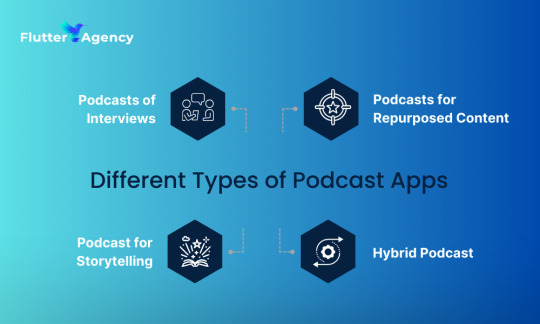
You should first know the different types of podcast apps before jumping to partnering with any mobile app development company in USA. It is a massive business, and thus, many avenues are open to you for telling tales through sound. Here are the major types of Podcasts applications:
1. Interviews and panel discussions podcast apps
As the name indicates, these podcast apps are designed for conversational formats like interviews and roundtable discussions. Generally, there is an anchor who drives the conversation and interviews a single or multiple guests at once.
2. Repurposed content podcast apps
Podcasts offer content creators a simple way to engage with an audience, in contrast to more conventional content production techniques like radio and television programs. Since they aren’t even currently subject to regulations, producing podcast content doesn’t require a broadcasting license.
3. Storytelling podcast apps
These podcasts have a huge fan following who like to listen to stories or tales that motivate or inspire them. The podcasts for storytelling can be based on true or made-up events. These are interesting as they captivate and hold the audience for a very short duration. They are, nevertheless, a bit difficult to master.
Many journalists and the media public prefer to listen to these podcasts to get the inside scoop on various topics and breaking events. Both factual and fictitious stories may be shared using storytelling art.
4. Hybrid podcast apps
In the hybrid podcasts, the present or anchor is the same for the whole podcast. Every episode, though, features a fresh and fascinating guest.
These podcasts are frequently used to record discussions, such as panels or interviews. The host gives introductory remarks or monologues before conducting in-depth interviews with the featured guest of the evening in each episode.
Why develop a podcast app?
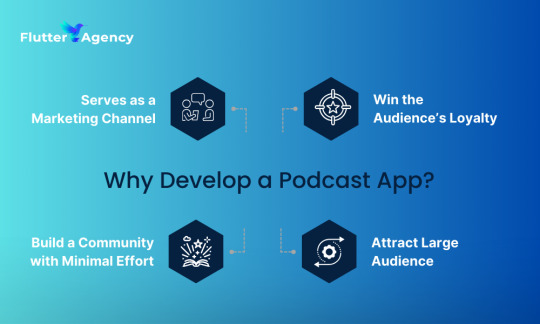
The major reason people prefer podcasts is the way they deliver the content. Podcasts are easily accessible, and they provide the required information in a comparatively shorter format. Here are the major benefits of the podcast app:
1. Serves as a marketing channel
It is possible to advertise your company offerings or services through a podcast app. You can use the app to introduce your business and provide information about the features of the platform.
2. Build a community with minimal effort
Suppose you want to build a podcast app dedicated to a niche interest group. You should be aware that there is a central theme in a podcast that attracts a dedicated audience.
3. Win the audience’s loyalty
You can win over listeners if you have a consistently charismatic presenter. In this way, the audience may want more of a presenter in a particular style, tone, voice, etc. It is essential to keep an eye on the material if you want to develop a community for podcasters and earn their confidence.
4. Attract large audience
You can reach a wide audience with a podcast app. The reason is its accessibility. It is a savior for people who don’t have time to go through huge resources or comprehend visual material. In those cases, audio format is a great alternative.
If you are looking forward to monetizing on the trend and want to build a podcast application, then you can pick the best mobile application development team for you project and see the innovation and creativity on screen.
Also Read: How to Build a Cost-Effective OTT App Like Hulu?
What are must-have features for Podcast mobile apps?
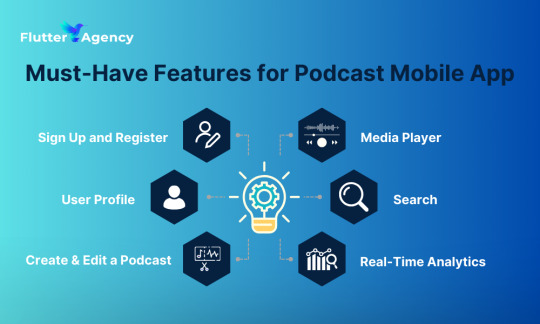
After knowing the importance of a podcast application, you must be wondering what features you should implement to make it successful. Here are the major features that you must consider for podcast mobile app development:
1. Sign up and register
The users should be able to register and create an account on the mobile app. They can use an email ID/contact number or also a social media login.
2. User profile
There will be a profile dashboard for users on which they can see their playlists and listener data. In addition, users can submit their information and preferences to receive more tailored suggestions from the app.
3. Create and edit a podcast
It is an essential feature for those who work directly in audio production. If you want to reach this demographic with the podcast app, you have to provide users with the option to record and edit the audio.
4. Search
Search is an essential feature of any app. It is the first element by which users start interacting with your app. The users should be able to find their favorite artists or content creators on the app using the search function.
5. Media Player
Without a streaming media player, there won’t be any app that could play audio. Users will have no trouble skipping between songs if you activate this function.
6. Real-Time analytics
Real-time analytics help you evaluate critical app data and make better choices about the app’s future development.
Looking To Build Your Podcast App?
Get in touch with our experts today to start your project!
Let's Discuss
Wrapping up
We have gone through various aspects of how to develop a podcast app. A podcast app business is having an attractive future. You can hire flutter developers who have vast experience in cross-platform app development with similar features and functionalities.
Share your business idea and vision with us and we can help you with an amazing application that aligns with your business objective!
#Build a Podcast App Like Stitcher#Podcast app development#different types of podcast apps#mobile app development company in USA#develop a podcast app
0 notes
Text
#Best Mobile Application Development#mobile apps development agency#Hire Flutter Developers#Build a podcast app#Podcast app development#Create a podcast app like Stitcher#Podcast app development company#Custom podcast app development#Stitcher-like podcast app#How to create a podcast app
0 notes
Text
#Build a Starbucks-like App#Cost-Effective App Development#Developing a Coffee Shop App#Starbucks App Clone#Cost to build an app like Starbucks#How to build a coffee app affordably
0 notes
Text
How to build a cost-effective App like Starbucks?
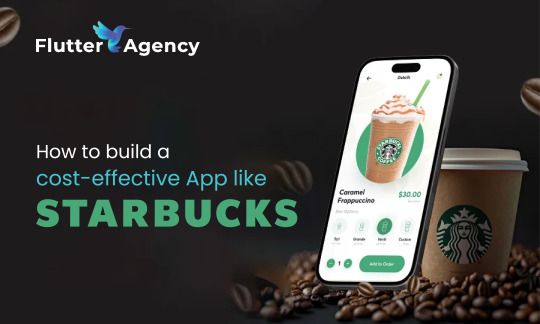
From cozy corners to customizable brews, Starbucks transforms coffee into an experience. This global giant dominates the caffeine landscape, offering convenience at every turn. Its familiar green logo beckons, promising more than just a drink – it’s a lifestyle. Starbucks reigns supreme in the world of quick, quality coffee.
Starbucks’ app significantly boosts its popularity. It allows customers to order ahead, earn rewards, and personalize their experience with just a few taps. It’s easy, and fast, and it makes getting coffee feel special.
So, what if you could build an app like Starbucks? One that boosts loyalty, keeps customers coming back, and simplifies life for users? As mobile apps are now vital in retail, let’s explore why the Starbucks app is so popular and how to create a similar one.
Starbucks App Popularity: Market Trends, Statistics, & Profit
Digital platforms reshape food service, with one-fifth of orders now placed online. Starbucks leads the charge, boasting 17 million app users who bypass queues.
This success ignites industry wide ambition. Businesses scramble to mimic Starbucks’ model, weighing options and costs. As consumers demand speed and ease, the food sector pivots to mobile-first strategies.
Companies rush to adapt, sensing a digital revolution that’s reshaping customer expectations and industry practices.
Reasons to Develop a Coffee App Like Starbucks

Creating a coffee app like Starbucks is very rewarding. As Starbucks’ U.S. revenue soars, mobile orders claim nearly a third of the pie. This surge mirrors a wider trend: consumers crave convenience, propelling the food and beverage app market’s explosive growth. The mobile ordering revolution is in full swing, reshaping how we dine and drink. It’s expected to grow significantly. By 2024, online food delivery revenue could hit $1.20 trillion. This forecast presents a golden chance for businesses to invest in mobile apps.
Modern Tech Stack Required to Develop An App Like Starbucks
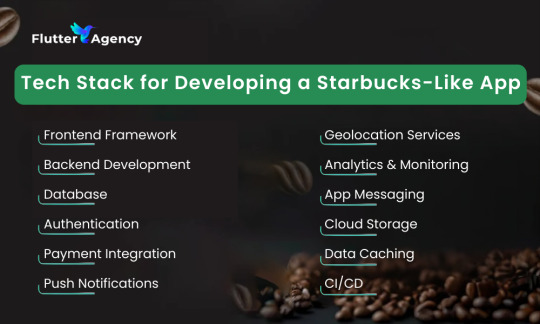
Frontend Framework
Flutter
A framework for building UIs that feel native on both iOS and Android, and works across platforms.
Backend Development
Node.js, Django, Firebase
Efficient backend frameworks for handling data management, API development, and real-time updates.
Database
Firebase Firestore, MongoDB, PostgreSQL
Databases that support scalability, real-time syncing, and complex queries for high-traffic apps.
Authentication
Firebase Auth, OAuth
Secure and easy-to-implement authentication solutions for managing user sign-ins.
Payment Integration
Stripe, PayPal, Apple Pay, Google Pay
Favored payment methods that provide secure and effortless transactions.
Push Notifications
Firebase Cloud Messaging (FCM)
Live updates for order progress, reward points, and offers.
Geolocation Services
Google Maps API, Apple Maps
Enables location-based services like store locators and delivery tracking.
Analytics & Monitoring
Google Analytics, Firebase Analytics
Tools to track user behavior, optimize app performance, and refine the user experience.
In-App Messaging
Twilio, Firebase In-App Messaging
For personalized communication with users regarding orders, loyalty updates, and promotions.
Cloud Storage
AWS S3, Google Cloud Storage
Secure cloud storage solutions for handling media and user data.
Data Caching
Redis, Hive
Ensures fast loading times and efficient data management, especially for repeat interactions.
CI/CD
GitHub Actions, Bitrise, Jenkins
Automated testing and deployment tools to streamline development cycles and improve release times.
This tech stack builds a quick, rich app. It manages high-traffic and complex tasks. Also, it offers a smooth experience across platforms.
A step-by-step guide to building an online food app like Starbucks

Here’s a detailed guide to building an online food app like Starbucks:
Step 1: Define App Objectives
Begin by establishing the app’s primary objectives. Decide whether the focus will be on mobile ordering, loyalty rewards, or both. Defining these early goals will help shape the app’s design and functionality, ensuring it meets user needs and stands out.
Step 2: Conduct Market Research
Analyze the landscape of food and beverage apps, examining major players like Starbucks. Identify popular features, user preferences, and market gaps. This research ensures your app aligns with industry trends and offers a competitive advantage.
Step 3: Plan Key Features
Decide on the essential features for your app’s success. Popular options include mobile ordering, loyalty programs, store locators, and personalized recommendations. The right mix enhances user satisfaction and meets business goals.
Step 4: Choose the Right Tech Stack
Choosing a flexible, scalable tech stack is crucial. For cross-platform development, hire Flutter app developers. They ensure a consistent UI on iOS and Android devices. Flutter offers efficient development cycles, cost-effectiveness, and customizable features to enhance app functionality.
Step 5: Develop an Engaging UI/UX Layout
Flutter’s customizable widgets let you create visually striking interfaces. Make your layout simple and intuitive to increase user satisfaction. A clean, easy design boosts retention and engagement. By following app design best practices, you create an interface that delights users and keeps them returning.
Step 6: Develop the Backend
Build a robust backend to manage user data, payment processing, and order handling. Frameworks like Node.js, Firebase, or Django provide the scalability and real-time capabilities needed for high-demand apps, ensuring a smooth experience.
Step 7: Integrate Core Functionalities
Work on integrating essential features like secure in-app payments, geolocation services, and push notifications for order updates. When you hire Flutter app developers, they can streamline this integration with third-party plugins for a seamless app experience.
Step 8: Conduct Thorough Testing
Run comprehensive testing to identify bugs and optimize app performance. Using manual, automated, and beta testing with real users ensures a smooth launch and professional experience for your audience.
Step 9: Launch and Gather Feedback
After launching, gather user feedback to pinpoint improvement areas. Track metrics and reviews. Use them to guide app updates. Refine the app based on actual user needs.
Step 10: Plan for Ongoing Maintenance
Keep your app fresh with regular updates. Enhance features, bolster security, and refine content. Stay attuned to user feedback and market trends. Consistent maintenance ensures your app remains relevant and competitive in the ever-evolving digital landscape. Continuous improvements retain interest and drive growth.
By taking these steps and hiring Flutter app developers, you can create a top-notch coffee app. It will be both user-centric and premium.
Also Read: Top 7 Food Delivery Apps in the USA
How much does it cost to develop an app similar to Starbucks?

1. Developer’s Location:
The developer’s location greatly affects app development costs. So, when planning a mobile app, consider if the pricing is hourly or project-based.
For a coffee shop app like Starbucks, hourly rates vary by region.
Developer Costs by Region:
North America: $120 – $150
South America: $50 – $80
Eastern Europe: $25 – $40
Western Europe: $25 – $50
Australia: $20 – $25
India: $15 – $20
2. App’s Complexity:
Your app’s complexity significantly affects its development cost. Here’s the average time needed for each stage in creating an app like Starbucks:
Discovery: Approximately 80 hours
Prototyping & Design: Around 200 hours
iOS & Android Development: Typically between 250 and 320 hours per platform
Backend Development: Estimated at 300 to 400 hours
Quality Assurance: About 100 hours
3. Development Platform:
Android or iOS? The Starbucks app works perfectly on any device. However, small coffee shop owners might not afford an app for all platforms. So, choosing a development platform that fits your needs and budget is crucial.
For a better grasp of costs, consider these app development estimates:
Development Type: Android or iOS
Backend Development: 200 – 500 hours, costing between $10,000 and $15,000
Frontend Development: 300 – 700 hours, costing between $15,000 and $25,000
Total Development Time: 500 – 1,200 hours, with an overall cost ranging from $10,000 to $25,000
Development Type: Cross-Platform
Backend Development: 200 – 500 hours, costing between $15,000 and $20,000
Frontend Development: 600 – 1,100 hours, costing between $20,000 and $30,000
Total Development Time: 800 – 1,600 hours, with an overall cost ranging from $15,000 to $30,000
Native versus cross-platform: a pivotal decision for app creators. Each path offers distinct advantages. Native development delivers superior performance and tailored user experiences but at a premium. Cross-platform extends reach across devices, yet demands greater investment in time and resources. The choice shapes your app’s capabilities, cost, and ultimate success. Weigh the tradeoffs carefully before embarking on your development journey.
To navigate these choices, work with top mobile app developers. They can give you useful insights. These experts can help you assess your business needs. They also aid in making decisions that balance functionality and cost. This collaboration ensures your app meets user expectations and stays within budget.
4. App UX/UI Features for a Coffee App Like Starbucks
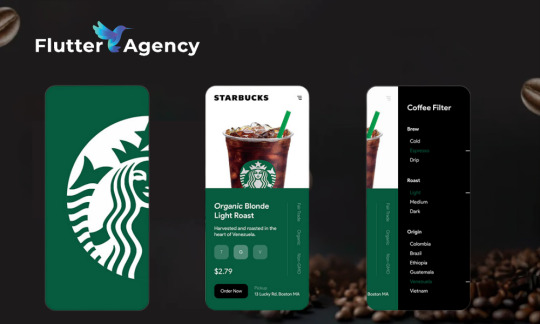
User-Centric Design:
Focus on intuitive navigation, allowing users to easily find their favorite drinks.
Visual Consistency:
Infuse the app with your brand’s signature hues and emblems, weaving a seamless visual tapestry.
Streamlined Checkout Process:
Reduce steps in the ordering process to cut friction.
Interactive Elements:
Engage users with animations or visual feedback when placing orders.
Personalization Options:
Allow users to save favorite orders and set preferences for notifications.
Accessibility Features:
Implement features such as adjustable text sizes and high-contrast visuals for inclusivity.
Performance Optimization:
Ensure fast page loads and smooth transitions to provide a better user experience. Focusing on key UX/UI features can boost satisfaction and loyalty in a coffee app. Apps like Starbucks show this success.
Want To Develop an App Like Starbucks?
Our experts can build secure, scalable, and user-friendly mobile Apps.
Let's Discuss
An Opportunity Brewing
Flutter Agency can turn your physical store into a thriving online platform. We excel in mobile app development, creating user-friendly coffee apps like Starbucks. Our apps boost engagement, simplify orders, and foster loyalty.
Don’t miss the chance to grow your business and meet the demand for convenience in coffee. Contact Flutter Agency today. Let’s create something exceptional together!
#Build a Starbucks-like App#Cost-Effective App Development#Developing a Coffee Shop App#Starbucks App Clone#Cost to build an app like Starbucks#Develop a Starbucks-style app on a budget#Affordable Starbucks app clone development#Mobile app development for coffee shops#How to build a coffee app affordably
0 notes
Text
#Build a Fitness App Like Peloton#Fitness App Development Like Peloton#How to Build a Fitness App Like Peloton#Create a Successful Fitness App#Develop a Fitness App Similar to Peloton#Peloton-Like App Development Guide#Build a Fitness App with Live Classes#Cost to Develop a Fitness App Like Peloton#Features of a Fitness App Like Peloton#Successful Fitness App Development Tips#Fitness App Development for Startups
0 notes
Text
How to Build a Successful Fitness App Like Peloton?

COVID-19 upended our world in 2020, closing gyms and studios. Yet fitness refused to falter. It simply migrated online, adapting swiftly to the new reality. Our routines shifted, but we stayed committed to our health. We found new ways to express ourselves online.
Apps like Peloton are vital for millions. They provided workouts and a community to connect with. This change wasn’t just due to the pandemic. It marked the start of a big shift in fitness – moving online.
People found they could meet their fitness goals at home. Since then, the demand for fitness coaching apps has exploded!
Now that the pandemic is over, fitness apps are here to stay – they’re the new normal! Apps offer more flexible, varied workouts than most gyms. You can find classes for spinning, yoga, strength training, or coaching.
Fitness apps enable home workouts. You can track progress and get real-time advice from trainers. Peloton offers more than just workouts. It creates an engaging, interactive experience. You feel connected to instructors and other users, despite the distance.
Fitness App Market Size & Trends
In 2023, the global fitness app market was valued at USD 9.25 billion. It’s projected to grow at a 14.08% annual rate from 2024 to 2030.
The COVID-19 pandemic caused nationwide lockdowns and more social distancing. It significantly impacted the industry.
A September 2020 World Economic Forum article said health and fitness apps had a 46% rise in global downloads.
The moment is ripe. Building a Peloton-like platform demands more than workout know-how. Master the tech: design an intuitive interface, integrate live sessions, and connect users. Success hinges on blending fitness expertise with cutting-edge digital innovation.
Key Features to Make Your Fitness Coaching App Like Peloton

Easy Sign-up & Profile Management
Let users register with an account with email or social login. Let them set fitness goals and customize their profiles. This will give them personalized workout recommendations.
Workout Library & Live Classes
Provide various workouts, both live and recorded. Organize them by type, length, and intensity for easy access.
Search & Filter Options
Include advanced search and filter options to help users find workouts easily. They should be able to sort by type, duration, intensity, or even their favorite trainers.
Progress Tracking & Analytics
Show users their progress with visual data on workout history, calories burned, and fitness goal achievements. This keeps them engaged and motivated.
Subscription & Payment Integration
It accepts credit cards, digital wallets, and in-app purchases. This simplifies subscribing to your services.
Push Notifications & Reminders
Use reminders to alert users about new classes, upcoming workouts, and milestone achievements. But make sure notifications are balanced and helpful, not overwhelming. Collaborate with developers to implement effective push notifications with top mobile app development services.
Trainer Profiles & Reviews
Let users view detailed profiles of trainers, including their specialties and previous class ratings. Allow users to leave reviews to add trust and help others choose the right class or coach.
Community Engagement & Social Sharing
Create a sense of community by implementing features like leaderboards, challenges, and social sharing. This helps build a stronger, more engaged user base.
Loyalty Programs & Rewards
Spark enthusiasm in fitness followers with outcome-oriented perks. Offer virtual badges, point systems, and exclusive discounts for hitting workout milestones and reaching personal goals. This creates an incentive to stay active within your app.
Multi-Device Syncing & Wearable
Sync your app with popular wearables for seamless fitness tracking. Live monitoring of vital stats and exercise data enhances the user experience. Fitbit and Apple Watch integration lets users access real-time heart rate, calorie burn, and workout metrics through your platform.
Customer Support
Enhance user experience with in-app support. Chatbots and live chat provide instant assistance, maintaining user engagement.
8 Steps to Develop a Fitness Coaching App Like Pelton
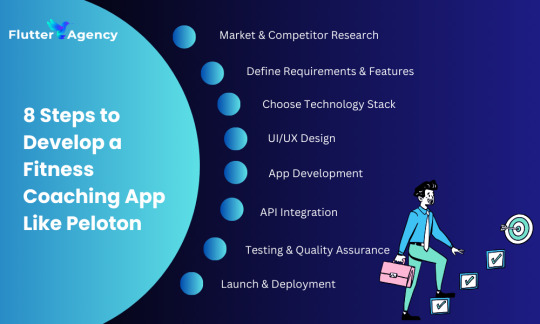
Step 1: Market Research & Competitor Analysis
Study successful fitness apps like Peloton, Nike Training Club, and Aaptiv. Study rivals’ assets and user tactics. Check customer reviews. Find market openings to make your app unique and tailored. Meet audience needs by filling gaps others miss. Stand out through strategic analysis and targeted development.
Step 2: Define App Requirements & Features
Outline the key features your app should have based on your audience’s needs. Must-have features typically include user registration, workout libraries, live sessions, progress tracking, and payment integration. This step is crucial for building a solid development plan.
Step 3: Choose the Right Technology Stack
Pick the right kind of technologies for both frontend and backend development. For a smooth cross-platform experience, use Flutter or React Native for the front end. For the backend, use Node.js or Ruby on Rails. They manage user profiles, workout data, and content well.
Step 4: UI/UX Design
Design wireframes and prototypes to map out the user journey. The design should focus on easy navigation through workout libraries, seamless class scheduling, and user engagement. Ensure the interface is intuitive and visually appealing to boost user retention.
Step 5: App Development
Develop the backend to manage class schedules, user profiles, workout data, and subscription services. The front end should focus on responsive designs, allowing users to access the app across various devices without performance issues. Consider hiring Mobile app developers for efficient cross-platform development.
Step 6: Integrating APIs
Integrate key APIs, like payment gateways (e.g., Stripe, PayPal), for smooth subscriptions. Also, consider adding wearable integrations like Apple Health or Google Fit. They would let users sync workout data and track progress.
Step 7: Testing & Quality Assurance
Test the app for functionality, performance, and security on various devices. Ensure it works smoothly on iOS and Android, with no bugs, lag, or security issues. This step is vital for a polished app and a good user experience.
Step 8: App Launch & Deployment
After testing, launch the app on the App Store and Google Play. Then, create a marketing strategy to generate buzz. Target fitness enthusiasts through social media, email, and influencers. Finally, offer updates and support to keep users engaged.
Hire Mobile app developers. They will speed up your app’s development. Your app will run smoothly on all platforms. This will give you an edge in the growing fitness app market.
Cost Breakdown for a Fitness Coaching App like Peloton

Design Costs: From wireframes to prototypes, design shapes your app’s foundation. This critical phase merges UI and UX, crafting an intuitive blueprint for development. Good design creates a smooth user experience. This creates a smooth user experience. This phase’s cost depends on its complexity and customization. But, investing in a professional design is vital for user retention.
Development Costs: This is often the largest expense and covers backend, frontend, and database development. Backend development manages user data, workout schedules, and subscriptions, while the frontend focuses on ensuring responsiveness and a seamless user interface. Partnering with top mobile app development services can help optimize this process.
API Integration Costs: We must add APIs for payment gateways (e.g., Stripe, PayPal) and fitness trackers (Apple Health, Google Fit). They are essential for functionality. The cost of API integration varies based on the number of systems and their complexity.
Testing & QA Costs: Testing ensures your app functions properly across devices. Both manual and automated testing are important to eliminate bugs and optimize performance. This step helps deliver a reliable, high-quality app to your users.
Maintenance & Updates: Post-launch support, feature upgrades, and regular bug fixes are ongoing expenses. These costs ensure your app remains up-to-date with technology and user expectations.
Approximate Cost: The cost of developing a fitness coaching app varies with its complexity. Basic apps begin at $30,000. Comprehensive versions may exceed $150,000. Costs vary widely between minimal and feature-rich mobile applications. Top mobile app development services can help you manage costs. They ensure the app meets high-quality standards.
Also Read: Fitness App Development in 2024: Market Size, Steps, Ideas and Features
Challenges in Developing a Fitness Coaching App like Peloton

Real-time Data Synchronization: A big challenge is managing real-time data. This includes class availability, live workout stats, and user progress. The app must sync data across devices and platforms. This will give users an accurate, up-to-date experience.
User Engagement & Retention: Keeping users engaged over the long term is essential for app success. Live classes, progress tracking, and community tools are vital. They motivate users. However, constantly creating engaging content and features can be a challenge that requires strategic planning.
Scalability: As your user base grows, the app must handle more traffic and usage. It must do this without losing performance. Making sure your app’s backend can grow is vital. Working with the best mobile app development agencies can help you create an app that expands your audience.
Data Security & Privacy: Fitness apps store sensitive data, like health metrics and payment info. So, security is a top priority. It’s critical to protect user data and build trust. So, we must comply with data privacy laws and use strong security measures.
Content Creation: To keep users returning, we must provide high-quality workout videos and instructions. It’s a challenge to maintain a steady stream of them. This requires working with fitness experts, videographers, and content creators. We must deliver fresh, engaging material.
Working with top mobile app developers can help you. They can overcome the challenges. They can create a successful, industry-standard fitness coaching app.
Wrapping It Up
In conclusion, making a fitness app like Peloton requires careful planning, smart development, and a deep knowledge of fitness. You can build a successful app for fitness fans worldwide. Do this by using key features, the right tech, and overcoming common challenges. With the right approach, your app can help users achieve their fitness goals. It can also make you a leader in the fitness app market.
Boost your fitness app’s impact with Flutter Agency. Our skilled team crafts compelling, goal-oriented apps that captivate users. We turn your vision into a powerful reality, elevating health and wellness experiences.
Build Your Fitness App Now!
Get started with our expert guide.
Let's Discuss
Our services include:
Customized fitness app development
Integration with wearable devices and social media platforms
Personalized coaching and training programs
Gamification and rewards systems
User-friendly interface design
Regular care and support
By partnering with us, you can:
Heighten user interaction and retention.
Elevate the user experience.
Differentiate yourself from your rivals.
Attain your company’s aims and targets.
Don’t settle for a mediocre fitness app. Flutter Agency crafts world-class solutions that stand out. Our expertise maximizes your app’s impact and revenue potential. Elevate your vision—reach out now and discover how we can propel your success together.
#Build a Fitness App Like Peloton#Fitness App Development Like Peloton#How to Build a Fitness App Like Peloton#Create a Successful Fitness App#Develop a Fitness App Similar to Peloton#Peloton-Like App Development Guide#Build a Fitness App with Live Classes#Cost to Develop a Fitness App Like Peloton#Features of a Fitness App Like Peloton#Successful Fitness App Development Tips#Fitness App Development for Startups
0 notes
Text
#Movie ticket booking app development#Build an app like Fandango#Online movie ticket booking app#Create a Fandango-like app#Movie ticket booking app features#Fandango app development cost#Custom movie booking app#Mobile app for movie tickets#How to build a movie ticket app#Fandango clone app development
0 notes
Text
Want to Build a Movie Ticket Booking App Like Fandango?

Historically, enjoying a film was not the effortless experience it is now. Viewers had to visit a cinema. At the venue, they frequently stood in lengthy queues to purchase tickets, particularly for blockbuster hits.
The old method offered no guarantees. It often left moviegoers empty-handed after hours of waiting. Now, a few taps on a screen can book prime spots for the latest blockbuster. It has turned a once-uncertain ritual into a swift, seamless experience.
Movie ticket booking has evolved. Fandango and BookMyShow lead this transformation, streamlining the cinema experience for all.
In 2021, the online movie ticket market was valued at $17.8 billion. It’s projected to hit $26 billion by 2027. This reflects a yearly growth of 6.52%.

Now’s your chance to launch a movie ticket app. The market is ready for the next Fandango. So, act quickly while cinephiles are eager to return to theaters.
What You’ll Learn Today:
Overview
Key Features + Advanced Features
Steps to Develop
Best Practices of Privacy and Security
Cost Breakdown for Developing a Movie Ticket Booking App
Challenges
Monetization Strategies
Key Features of a Movie Ticket Booking App like Fandango

User Registration & Profile Management: Fast sign-ups and sign-ins draw users through email, social media, and mobile. Expert Flutter developers ensure easy sign-ups, converting newcomers to regulars. A beautiful app design first attracts users and then keeps them coming back.
Real-Time Movie Listings & Showtimes: Display up-to-the-minute showtimes with integrated movie databases. Users can filter by location, genre, or language, finding exactly what they want.
Interactive Seat Selection: Let users select their preferred seats effortlessly with real-time availability displayed on an interactive map. A simple yet essential feature for an enhanced booking experience.
Payment Gateway Integration: offers secure payment options for easy checkout. Use credit cards, e-wallets, and UPI. Skilled Flutter developers can integrate these payment gateways for safe, simple transactions.
Push Notifications: Send timely alerts about bookings, upcoming movies, and promos to keep users engaged. Expert Flutter developers can ensure your push notifications are both relevant and engaging, keeping users connected.
Social Media Integration: Enable users to share their bookings and reviews across social platforms, driving organic promotion for your app. With the right Flutter expertise, you can build seamless social media integration to enhance user engagement.
In-App Movie Trailers & Details: Show movie trailers, descriptions, cast details, and user reviews to help users make informed decisions. A great user interface, made with top mobile app development services, can improve the movie selection experience.
Multi-Language & Multi-Currency Support: Hire Flutter app developers. They can easily add support for multiple languages and currencies. This will expand your user base.
Loyalty Programs & Discounts: Reward Offer discounts to boost engagement. A thoughtfully designed loyalty program can help retain customers and encourage repeat usage.
Customer Support & Feedback: Add chatbots or 24/7 live support for user queries and feedback. Seamless customer support boosts app value, keeping users satisfied and engaged.
Must-Have Advanced Features

Geolocation & Theater Finder: Use the current location to find nearby theaters. It will help users catch the next show.
Food and Beverage Pre-Order: Allow users to pre-order snacks and drinks when booking tickets. This lets them skip the concession line and enjoy the movie.
Seat Reservation Reminder: Send timely notifications to remind users of their reserved seats, ensuring they don’t miss out on their movie experience.
Event and Show Integration: Expand beyond movies. Offer bookings for concerts, live shows, and sports events. This will give users more entertainment options.
A 7-Step Guide to Develop a Movie Ticket Booking App like Fandango
Step 1: Market Research & Competitor Analysis
Research Existing Apps: Analyze Fandango, BookMyShow, and Atom Tickets. Understand their features and user engagement strategies.
Identify Gaps: Find areas where these platforms fall short. Focus on user experience and unique features your app can offer.
Consult with Experts: Work with top mobile app developers. They can share trends and strategies.
Step 2: Define App Requirements & Features
Feature List: Create a list of essential features. Include real-time booking, interactive seat selection, and various payment options.
MVP vs. Full App: Decide whether to launch a Minimal Viable Product (MVP) with core features or a full app.
User Stories: Create user personas and scenarios. They will guide feature prioritization and align with user needs.
Step 3: Choose the Right Technology Stack (Recommended by us, not limited to)

Step 4: App Development
Backend Development: Build the backend to manage user accounts, movie listings, bookings, and payments efficiently.
Frontend Development: Design user-friendly features like movie search, seat selection, and booking confirmations for a smooth experience.
Step 5: Integrating APIs
Movie Database API: Connect APIs like TMDb for real-time movie info and showtimes.
Payment Gateway: You can simplify payment acceptance by connecting secure gateways like Stripe or PayPal. This makes the process smooth and safe for everyone involved.
Geolocation: This feature so users can find nearby theaters.
Step 6: Testing & Quality Assurance
Functional Testing: Make sure key features like bookings and payments function perfectly.
Performance Testing: Check if the app can handle high traffic smoothly.
Security Testing: Guarantee data protection and compliance with security standards.
Step 7: App Launch & Deployment
Prepare for Launch: Before submitting the app to the stores, create a marketing strategy. Use social media, email campaigns, and press releases.
Monitor Feedback: After launch, track user feedback and analytics. Use them to improve the user experience.
Best Privacy and Security Practices for Movie Ticket Apps
A movie ticket app must secure user data, especially payment info. Prioritizing privacy and security builds trust. It also ensures compliance with GDPR and CCPA.
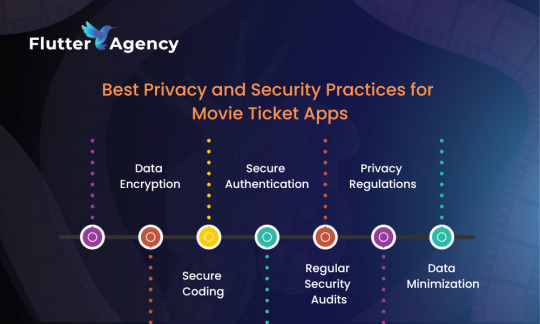
Data Encryption: Data travels through SSL/TLS encryption in a secure manner. Once stored, AES safeguards it at rest. This dual approach shields sensitive information throughout its lifecycle, from transmission to storage.
Secure Authentication: Secure sign-ins leverage OAuth 2.0 and Firebase Authentication. These systems use multi-factor authentication and password hashing. They protect user access with advanced security protocols.
Compliance with Privacy Regulations: We comply with GDPR and CCPA. We let users access, modify, or delete their data. We also use opt-in consent for data collection.
Secure Coding: Our dev team follows secure coding standards to prevent SQL injection and XSS. We conduct regular code reviews and penetration tests.
Regular Security Audits: We run frequent security audits and monitor the app. This addresses risks and keeps it safe.
Data Minimization: Essential data collection minimizes breach risks. Role-based access control restricts user authorization and safeguarding information. Our streamlined approach balances security and efficiency.
These practices protect user data. They create a trusted, safe environment for booking movie tickets.
Also Read: How to Build a Cost-Effective OTT App Like Hulu?
Cost of Developing a Movie Ticket Booking App
An elevated cost doesn’t necessarily indicate superior quality. You might pay more for a team with a strong portfolio. Yet, if they lack the right skills for your project, you won’t get the needed quality. So, check your team’s skills and experience first. Ask if they’ve built apps like yours before. Do they have expertise in security, user experience, or cloud integration? By assessing your team’s abilities, you can ensure good quality, no matter the cost.
Ticket booking apps vary in price. A single-platform version costs $10,000 to $30,000. Multi-platform options can reach $45,000. For precise Fandango-like app estimates, consult leading mobile developers such as Flutter Agency. Costs vary based on features, design complexity, and platform choices.
Challenges of Developing a Movie Ticket Booking App
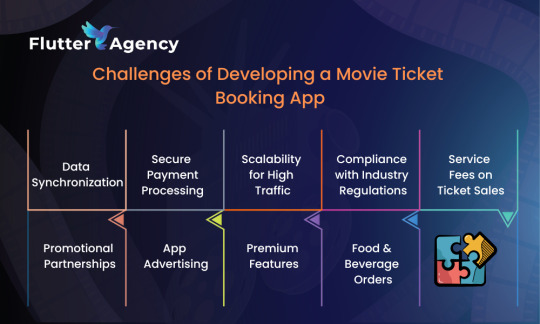
Real-time Data Synchronization: Handling real-time updates for seat availability, showtimes, and bookings can be complex and requires reliable backend support.
Secure Payment Processing: Ensuring secure and fast transactions for diverse payment methods is crucial for user trust and satisfaction.
Scalability for High Traffic: We must manage server loads during peak times, like blockbuster releases. This is vital to app performance and user experience.
Compliance with Industry Regulations: It is vital to follow regional guidelines. This is true when operating in global markets with varying legal requirements. Monetization Strategies for Movie Ticket Booking Apps like Fandango
Service Fees on Ticket Sales: A service fee for booking through the platform can create a steady revenue stream.
Promotional Partnerships: Collaborating with theaters, movie distributors, and event organizers can enhance offerings and provide additional income opportunities.
In-App Advertising: Showcasing ads for upcoming movies, events, and brands allows for additional monetization without impacting user experience significantly.
Premium Features: Offering early access to tickets, special discounts, or VIP seat bookings can entice users to pay extra for enhanced experiences.
Revenue from the Food and Beverage Orders: Commission from F&B pre-orders through the app can supplement ticket sales and enhance user convenience.
Start Building a Movie Ticket App Today!
Join us to explore the steps for launching your movie ticket booking app successfully!
Let's Discuss
Bring Your Movie Ticket Booking App to Life
The success of a movie ticket booking app primarily depends on one core factor: its ability to deliver a premium user experience. And working with an experienced development team like ours at mobile app development agencies ensures that that happens.
We’re a premium app development company that builds 100% customizable tech solutions meeting the highest quality standards so that your movie ticket booking app users get nothing but the best experience.
#Movie ticket booking app development#Build an app like Fandango#Online movie ticket booking app#Create a Fandango-like app#Movie ticket booking app features#Fandango app development cost#Custom movie booking app#Mobile app for movie tickets#How to build a movie ticket app#Fandango clone app development
0 notes
Text
Want to Build an eCommerce App like The Home Depot? Explore Features & Costs!
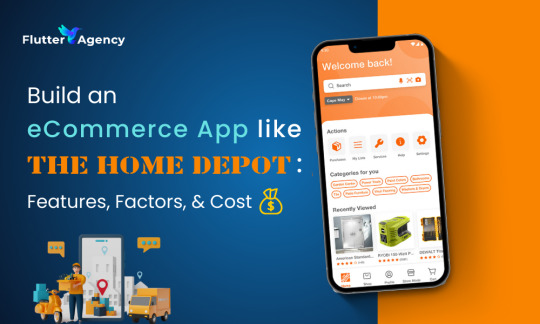
Apps revolutionize home improvements. Homeowners now tap screens for repairs, materials, and DIY guidance. On-demand services surge, connecting residents with pros instantly. Digital platforms streamline projects, from minor fixes to major renovations. This tech-driven shift transforms how we maintain and upgrade our living spaces.
A rising market beckons innovators. Developers now face a prime chance to build an all-encompassing platform—a digital Home Depot for the tech world. This one-stop solution could revolutionize how we access and integrate diverse technologies.
Building an app similar to Home Depot can be highly profitable.
From renovation inspiration to expert guidance, your app transforms home improvement. Users instantly access a vast product selection, professional advice, and essential services. It’s the all-in-one solution for DIY enthusiasts and homeowners alike, delivering tools, ideas, and assistance with a tap. This digital hub streamlines projects, making home enhancement effortless and accessible.
Step-by-Step Process to Build an On-Demand Home Service App like Home Depot
Step 1: First, pinpoint your audience. Homeowners seeking repairs? Contractors hunting supplies? DIY enthusiasts planning projects? Know their needs. Then, dive deep into market research. This crucial step shapes your app’s features. Don’t rush development. Instead, invest time in understanding your users. Their desires will guide your creation, leading to a product that resonates with a profound impact. Remember, thorough preparation paves the way for success in the competitive app landscape.
Analyze Home Depot, Lowe’s, and TaskRabbit’s platforms to identify market openings. Learn from their strengths and sidestep their flaws. Tailor your app with unique features through custom development. By filling gaps and surpassing user needs, your product will stand out in a crowded field, securing its own distinctive space in the market.
Feature List
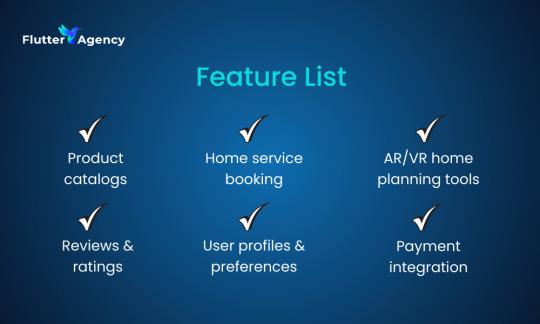
Product catalogs: From power tools to plumbing fixtures, our store stocks everything for your home projects. Browse aisles filled with quality building materials and essential hardware. Find the perfect items to renovate, repair, or upgrade any space in your house.
On-demand booking for home services: Book skilled pros for plumbing, painting, electrical jobs, and beyond. Our platform connects you with vetted experts, making home services hassle-free.
AR/VR tools for home planning (optional): Visualize renovations virtually before committing. This tool lets homeowners preview improvements, aiding confident decisions on home upgrades. See your space transformed digitally, ensuring satisfaction before investing time and money.
User profiles and preferences: Store user preferences and purchase history to tailor their experience. This personal touch enhances engagement and satisfaction.
Payment gateways: Ensure secure and seamless transactions through various payment options.
Customer reviews and ratings: Let users share and explore honest feedback. Reviews build confidence in products and services while fostering community trust.
Custom-built features elevate your app, transforming it into a home improvement must-have. Your platform transforms into an irresistible renovation powerhouse, fueled by top-tier development expertise. Users flock to this ultimate solution, revolutionizing their projects with ease and efficiency.
Step 2: Define the Core Features of the App
A stellar home service app mirrors Home Depot’s core strengths. It seamlessly guides users through tasks, enhancing their experience at every turn. Key elements include intuitive navigation, robust search functions, and detailed product catalogs.
These features, working in harmony, create an efficient, user-centric digital ecosystem for home improvement needs.
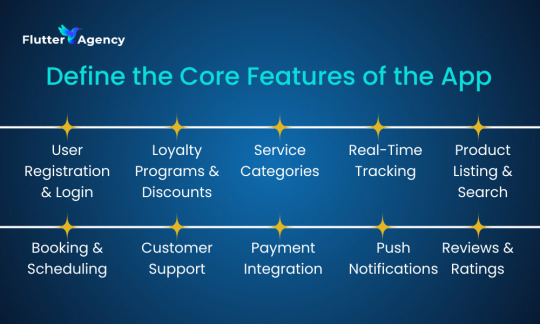
User Registration & Authentication: Social, email, or phone signups streamline user access. Quick logins enable effortless account creation and smooth entry to the platform.
Service Categories: Group services by type: electrical, plumbing, HVAC, and beyond. This streamlined approach helps users quickly locate their desired assistance.
Product Listing & Search Functionality: Users can quickly locate ideal products through our expansive database. Intuitive search filters for price, ratings, and relevance streamline the shopping experience, ensuring efficient and satisfying item discovery.
Booking & Scheduling: Book services and appointments effortlessly with our user-friendly system. Seamlessly integrated calendars streamline scheduling, ensuring maximum convenience for all users. This intuitive platform simplifies the entire booking process, saving time and reducing hassle.
Real-Time Tracking: Track deliveries and services in real-time. Keep users informed every step of the way. Instant updates ensure peace of mind and build trust.
Payment Gateway: Safeguard transactions with diverse payment methods. Accept credit cards, mobile wallets, and PayPal to ensure smooth, secure processing for all customers.
Reviews & Ratings: Feedback fuels progress. Ratings build credibility. By embracing user input, custom app development services evolve. Unlock these tools to elevate quality and earn trust. Continuous improvement thrives on customer voices.
Push Notifications: Keep users hooked with quick pings. Flash enticing deals, track shipments, and nudge about services. Timely notifications foster engagement and spark action.
Customer Support: Chatbots and live agents offer seamless support access. Integrate these tools directly into your platform for swift user assistance. This user-friendly approach enhances satisfaction and resolves issues efficiently.
Loyalty Programs & Discounts: Incentivize loyal patrons through exclusive deals, price cuts, and reward points, fostering return visits and sustained engagement.
For a polished cross-platform solution, consider enlisting Flutter experts. Skilled developers transform app features into captivating experiences, delighting users with seamless interactions across all devices.
Step 3: Design the User Interface (UI/UX)
Crafting a smooth, captivating interface is key to an app’s triumph. For Home Depot’s digital platform, this means seamlessly blending services and products into a user-friendly design that hooks customers and drives success. Here’s how to approach the design phase:
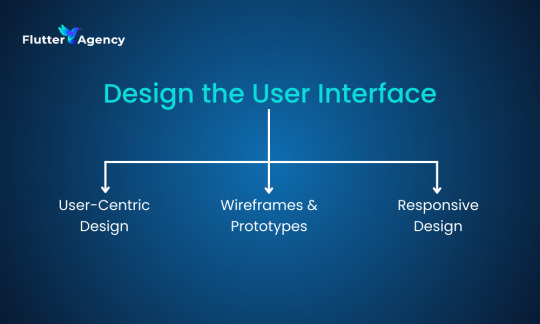
User-Centric Design: Simplicity guides our app’s design. Users navigate swiftly to products, services, and expert advice. Intuitive interfaces ensure effortless exploration for all. Newcomers and veterans alike find efficiency at their fingertips. The digital landscape unfolds seamlessly, prioritizing ease of use. User-friendly elements reign supreme, creating a fluid experience throughout.
Wireframes & Prototypes: Map key user flows with wireframes. Visualize the home screen, product search, and service booking. Prototypes reveal the user’s path, highlighting crucial features. This approach ensures easy access to essential elements throughout the journey.
Responsive Design: From smartphones to desktops, our app adapts seamlessly. It delivers a uniform experience across devices, adjusting to various screen sizes with precision. Users enjoy flawless functionality whether they’re swiping on tablets or clicking on laptops. This versatility ensures everyone can access and navigate the app effortlessly, regardless of their preferred platform.
A sleek, intuitive interface rivals industry giants, drawing users in and keeping them engaged. Your app’s seamless design becomes its competitive edge, fostering customer loyalty and market share growth.
Also Read: How? Develop On-Demand Delivery App For Your Business
Step 4: Develop the App (Front-End & Back-End)
With the design in place, we can now move on to developing the app. Here’s a breakdown of key steps:

Choose a Development Platform: It’s a crucial choice for e-commerce mobile app development. iOS and Android offer platform-specific advantages, while frameworks like Flutter and React Native promise efficiency. With a single codebase, Flutter streamlines development for both platforms, potentially saving time and resources. Weigh your options carefully to align with project goals and team expertise.
Front-End Development: Craft sleek, dynamic interfaces mirroring your wireframes. Polish UI components for swift performance and frictionless user interactions. Prioritize responsiveness and seamless functionality to elevate the overall experience.
Back-End Development: Here’s where the app’s core functionality takes shape. Set up servers, databases, and APIs to power its key features, including:
Service catalog management: Compile and adjust information about services, products, and divisions.
User data storage: Safeguard personal data, preferences, and booking history.
Payment processing: Implement secure payment gateways for transactions.
Admin Dashboard: Develop an admin panel that allows the app’s managers to handle user data, services, orders, payments, and customer support. This helps streamline backend operations and ensures smooth management.
Third-Party Integrations: Integrate external APIs to enhance functionality. These may include:
Geolocation for tracking deliveries and services.
Transaction handling for safe, smooth exchanges.
SMS notifications for timely alerts on service bookings, delivery updates, and promotions.
Merge elegant interface design with powerful server-side capabilities to create an app that flows effortlessly. Hire Flutter mobile app developers, particularly those versed in Flutter, to construct a durable, expandable system. Aim for the polished performance of Home Depot’s app, ensuring user delight and room for future expansion. This strategy paves the way for sustained success and happy customers.
Step 5: Testing & Quality Assurance
Rigorous testing safeguards your app’s quality. Prioritize thorough quality assurance to guarantee users a seamless experience before release. Here’s how to approach it:
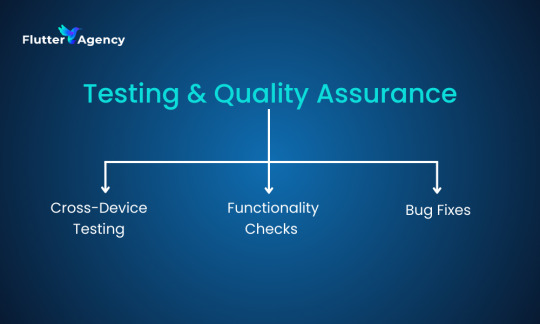
Test Across Devices: From iPhones to Androids, tablets to phones, our app must shine on every screen. We’ll rigorously test across devices, ensuring smooth operation and visual harmony. No matter the OS or display size, users deserve a flawless, unified experience.
Functionality Testing: Rigorously examine the app’s key functions: appointments, transactions, item lookup, and user data handling. Verify seamless operation across all systems. Test thoroughly to catch any bugs or hiccups. Ensure a smooth user experience from start to finish.
Bug Fixes: Bugs uncovered in testing demand swift fixes. Post-launch, attentiveness to user input drives ongoing app refinement. These efforts ensure seamless operation and satisfied users. Vigilance in both phases – pre and post-release – is key to app success.
Step 6: Launch & Marketing
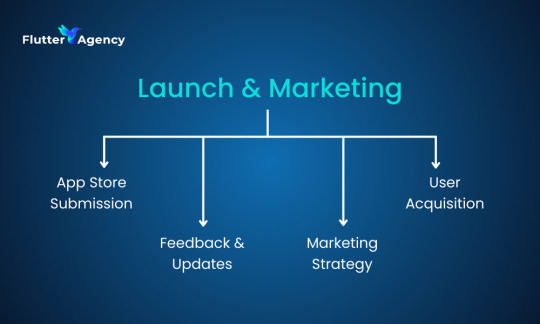
App Store Submission: Launch your app on the Google Play Store and Apple App Store. Follow each platform’s guidelines to avoid delays.
Marketing Strategy: Engage users through a diverse app marketing approach. Start by harnessing social media’s vast audience. Next, forge partnerships with influential voices in your niche. Finally, launch precision-targeted Google Ads campaigns. This three-step approach maximizes visibility, credibility, and user acquisition for your app.
User Acquisition: Create buzz and encourage downloads. Offer discounts to early users. Consider referral programs to help expand your user base.
Feedback and Updates: Regularly collect user feedback to enhance the app. Also, update it often with new features and fixes to keep users engaged and loyal.
By testing and marketing your app, it will work as intended. It will also gain traction in a competitive market.
Cost of Developing an On-Demand Home Service App Like Home Depot
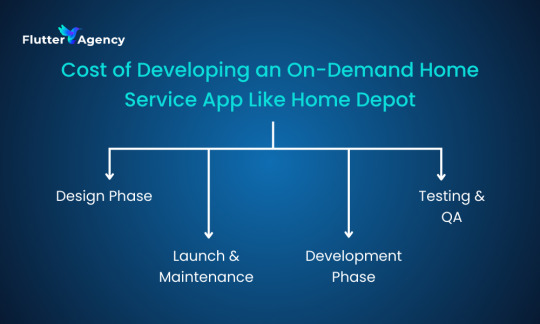
Design Phase
UI/UX Design: $5,000 – $15,000
Wireframing & Prototyping: $2,000 – $5,000
Development Phase
Front-End Development: $15,000 – $40,000
Back-End Development: $20,000 – $60,000
Admin Dashboard: $5,000 – $15,000
API Integrations: $3,000 – $10,000
Testing and QA
Testing: $5,000 – $15,000
Bug Fixes: $2,000 – $7,000
Launch and Post-Launch Maintenance
Marketing & Promotion: $10,000 – $30,000
App Store Submission: $1,000 – $2,000
Maintenance (annually): $10,000 – $30,000
Estimated Total Development Cost: $70,000 – $200,000 (depending on complexity and features)
Final Thoughts
Creating a home service app taps into the growing need for easy home improvements. Similar to Home Depot, you can offer products, services, and expert advice. This approach will attract homeowners, contractors, and DIY fans. Moreover, you can earn money through product sales, service bookings, and ads. This means your growth potential is significant.
Working with custom app developers lets you create apps that meet user needs. This gives you a competitive edge in the growing market. The home improvement sector is growing. Now is the best time to invest in a simple, strong app.
#Build eCommerce App Like The Home Depot#Build The Home Depot Clone App#Custom App Development Services#The Home Depot App Development Cost#Home Service App Development Cost#On-Demand Home Service App#Features of Home Service App#eCommerce App Development Company
0 notes
Text
#Build Home Service App Like Home Depot#Build Home Depot Clone App#Custom App Development Services#Home Depot App Development Cost#Home Service App Development Cost#On-Demand Home Service App#Features of Home Service App#Cost of Develop On-Demand Home Service App#eCommerce App Development Company
0 notes
Text
How to Build a Ridesharing App like Lyft: Key Features & Development Costs
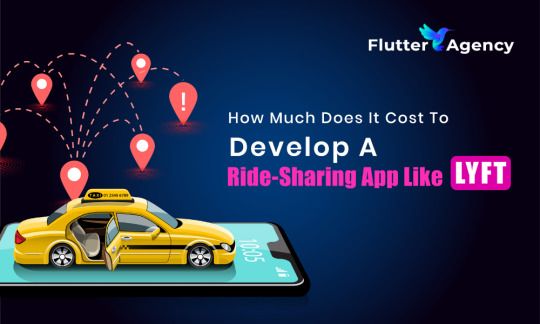
Lyft and similar services revolutionized travel, boosting accessibility and efficiency. These ride-sharing apps improved transport and user experience. They also changed urban mobility.
The demand for custom application development services surges as digital needs increase. Businesses scramble to meet soaring demand for tailored software solutions. It allows businesses to tap into a thriving market.
Why Build a Ride-Sharing App Now?
In 2023, the ride-sharing industry hit $106.70 billion globally. Projections for 2024 show a climb to $126.46 billion. By 2034, experts foresee a staggering $691.63 billion valuation. This sector’s robust 18.52% yearly growth rate, spanning 2024 to 2034, signals a transformative decade ahead for urban mobility and transportation economics (source)
Urban sprawl, pricey gas, and eco-friendly trends fuel ride-sharing’s rise. Commuters and companies alike embrace this cost-effective, green transport solution. As cities grow and budgets shrink, shared rides beat solo driving.
Ride-sharing apps offer lucrative opportunities for businesses of all sizes. New players can challenge industry giants by targeting niches or local markets. Innovative features set newcomers apart in this essential urban service. As AI and self-driving tech evolve, custom apps unlock growing markets.
Both startups and established firms can profit from this transport revolution. They can carve out a niche in an ever-expanding digital world.
Key Features Required for a Successful Ride-Sharing App
Seamless experiences drive successful ride-sharing apps. Users crave intuitive interfaces for quick bookings, real-time tracking, and secure payments. Drivers need efficient route planning, fair compensation, and easy communication.
Both benefit from robust profiles, rating systems, and responsive customer support. Safety features like emergency contacts and driver verification build trust. Integrating maps, GPS, and push notifications ensures smooth operations.
A well-crafted app balances these elements, creating a user-friendly ecosystem that keeps riders coming back and drivers engaged. Constant refinement based on feedback fuels continuous improvement, keeping the app competitive in a crowded market.
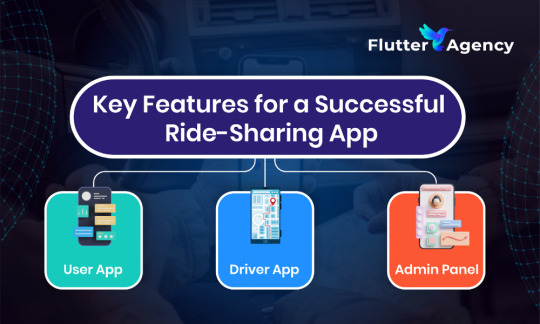
User App:
Simple Registration and Onboarding: Connect effortlessly. Email, phone, or social media—pick your path. Our swift signup process welcomes all users, boosting retention through seamless onboarding. Create your account now and join our community without delay.
Book, estimate, track: Riders crave simplicity. A few taps should secure transport, reveal costs, and display live journey updates on an interactive map. Seamless functionality empowers passengers, transforming travel into a smooth, predictable experience.
Payment Gateway Integration: Streamline purchases with multiple payment options: credit, debit, and e-wallets. Quick, hassle-free transactions await.
Feedback: Riders can rate and review drivers. This ensures high service standards.
Driver App:
Driver Profile Setup and Verification: Drivers must create a profile and verify their identity for safety.
Ride Request Notifications and Navigation Assistance: Drivers get ride requests. They use the app to navigate to destinations quickly.
Earnings Dashboard: Clear financial insights await drivers who monitor their earnings. Daily, weekly, and monthly tracking illuminates income patterns, empowering informed decisions and goal-setting. This comprehensive view of finances fuels motivation and strategic planning for success on the road.
Ratings and Reviews from Riders: Rider feedback ensures that drivers provide high-quality service and performance.
Admin Panel:
User and Driver Management: The admin can monitor both drivers and users. This ensures smooth operations and resolves any issues.
Analytics and Reports: Analytics lets admins check ride frequency, user behavior, and revenue. This improves the app’s performance.
Fraud Detection and Prevention: Automatic processes reveal con activities, maintaining the platform’s reputation.
To develop these features, invest in custom app development. It will ensure your app runs well and scales with demand.
The Importance of Real-Time Features
Real-time features are crucial to a ride-sharing app. They ensure riders and drivers get accurate, up-to-date information. This is key for the app’s functionality and user experience. Let’s explore the key real-time components:
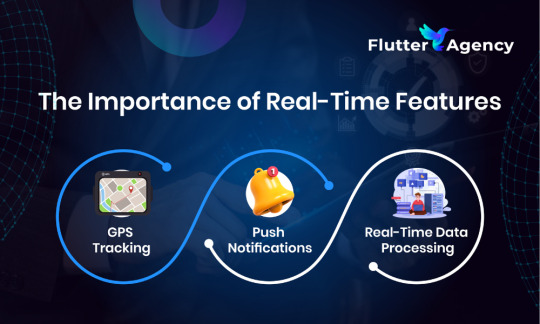
1. GPS Tracking
Lyft’s ride-sharing app hinges on real-time GPS tracking. This vital feature pinpoints vehicle locations instantly, keeping both drivers and passengers informed throughout their journey. The technology turns smartphones into dynamic maps. They show moving cars as they navigate city streets. This helps coordinate pickups, estimate arrival times, and ensure safety. Riders can track their driver’s route and ETA. Drivers can use it for turn-by-turn navigation. This feature boosts transparency and trust between the service and its users. It improves the overall experience.
2. Push Notifications
Push notifications play a critical role in keeping users informed. Riders get updates on requests, arrivals, and payments. Drivers are notified of new requests. They get updates on rider locations and cancellations. This constant communication keeps users informed, without checking the app. It makes the ride process smooth.
3. Real-Time Data Processing
To deliver a seamless booking experience, real-time data processing is essential. Low-latency data transmission ensures quick ride matching, updates, and fare calculations. For example, when a user books a ride, the system quickly checks available drivers, arrival times, and distances. It then provides instant feedback. This fast processing reduces delays. As a result, both drivers and riders enjoy a smooth, efficient experience.
Real-time features like GPS and notifications boost user satisfaction, safety, and efficiency.
Technology Stack for Building a Ride-Sharing App
A robust, scalable tech stack forms the backbone of any successful ride-sharing app. Lyft’s model demands a powerful foundation to handle high user demand, real-time data processing, and seamless transactions. It must handle real-time data, user interactions, and geolocation services. Here’s a breakdown of essential components:
Mobile Development Frameworks:
When choosing a framework for mobile app development, prioritize performance and user experience. Some of the most popular options include:
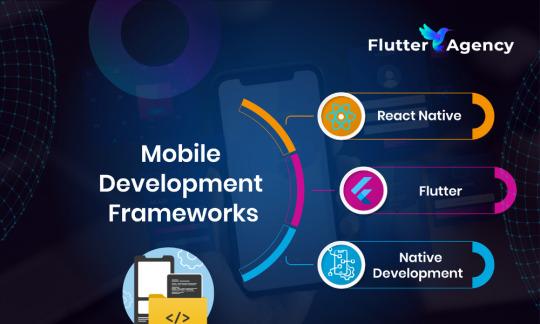
React Native: React Native is a popular framework for cross-platform apps. It lets developers create a shared codebase for iOS and Android. This speeds up development.
Flutter: Flutter is known for its speed and expressive UI. It’s perfect for startups and businesses that need quick app development. You can hire Flutter experts for faster and more efficient application development. Swift delivery meets user satisfaction in this balanced strategy, accelerating launch without compromising excellence.
Native Development (iOS/Android): For peak performance, use Swift (iOS) or Kotlin (Android) for native development. Native apps usually have better access to device hardware and sensors.
Backend Technology:
A reliable backend is the backbone of a ride-sharing app. Matching riders in real time, verifying users, and tracking locations are core functions this system manages seamlessly. It deftly coordinates these vital processes to keep operations running smoothly.
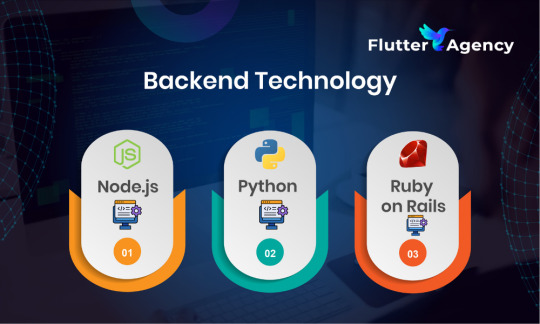
Node.js: Node.js is fast and scalable. It’s popular for real-time apps, making it perfect for a ride-sharing platform.
Python (Django): Python’s Django framework excels in web development. Its sleek design enables fast, scalable projects. Developers prize Django for its practical approach and high-level functionality.
Ruby on Rails: Startups thrive with Ruby on Rails. Its sleek syntax boosts productivity, making it an ideal framework for new ventures.
APIs and Tools:
To enable geolocation, payments, and chat, we must use third-party APIs and tools.
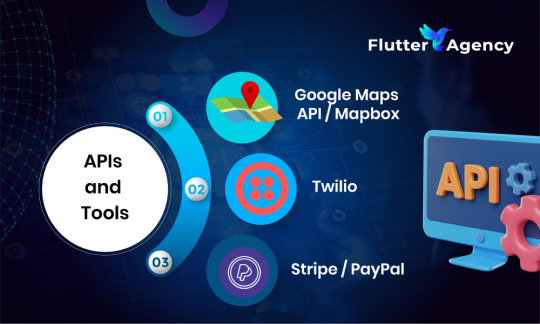
Google Maps API / Mapbox: These services allow users and drivers to track rides. They can estimate arrival times and navigate routes using real-time mapping and geolocation features.
Twilio: Twilio simplifies adding messaging services. It’s for SMS notifications and rider-driver communication.
Stripe / PayPal: For seamless payment processing, use payment gateways like Stripe or PayPal. They ensure secure transactions for users and drivers.
A ride-sharing app’s fate hinges on its tech stack. The right choice fuels growth, handles demand, and delights users. Smart developers weigh options carefully, knowing their decision shapes the app’s future.
A ridesharing app’s price tag in 2024 ranges from $70,000 to $200,000. Complexity, features, and technology choices drive costs up or down within this spectrum. Developers must achieve a balance between functionality and budgets when creating Lyft-like platforms.
Breakdown of Costs:
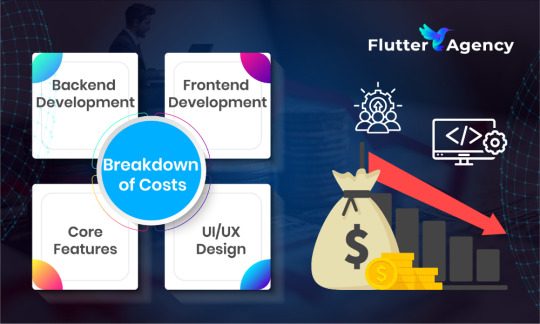
Backend Development: Tech stacks shape backend costs. Node.js, Django, or Ruby on Rails influence pricing for critical services. User authentication and payment gateways range from $3,500 to $20,000, depending on complexity and chosen framework.
Frontend Development: Cross-platform frameworks slash frontend costs. React Native and Flutter offer savings, with prices spanning $6,000 to $36,000. Feature complexity and target platform – iOS or Android – drive the final bill. Savvy developers leverage these tools to create mobile apps that are both efficient and budget-friendly.
Core Features: Features like geolocation and ride-booking will cost about $6,000 each. Adding advanced options like split fares and scheduling rides can increase the cost by $6,000 to $8,000 each.
UI/UX Design: A design that is easy to use on both iOS and Android devices will cost over $12,000.
The cost also depends on extra features. These include real-time tracking, fare splitting, and driver management systems. Remember that maintenance, marketing, and updates will increase the budget.
Also Read: Guide to Create Uber like Clone Taxi Application
Challenges in Developing a Ride-Sharing App
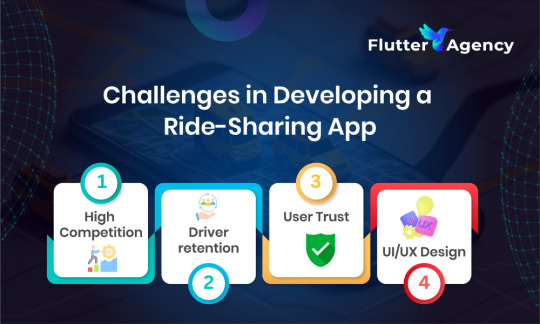
High Competition: The ride-sharing market has giants such as Lyft. These companies have significant brand recognition, financial resources, and advanced features. To stand out, a new app must be unique. It must offer new features or serve a niche market. This will distinguish it from its competition.
Driver retention: Engaged, motivated drivers drive success. Bonuses, flexible hours, and rewards spark retention. Smart incentives keep your team on the road and committed to excellence. However, many new platforms struggle to profit while providing these perks.
User Trust: Building trust with users is essential. This means using strong security, clear pricing, and full insurance. It also means high-quality service, with regular driver checks. Trustworthy experiences attract repeat customers and positive reviews. They are vital for growth in a competitive market.
Future Trends in Ride-Sharing Apps
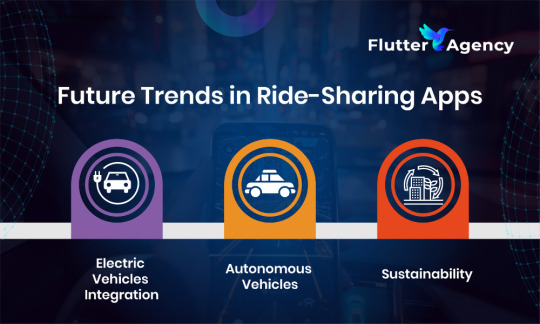
Electric Vehicles (EV) Integration: Electric cars are transforming ride-sharing. Uber and Lyft plan all-electric fleets by 2030, driven by sustainability goals. This green shift slashes emissions, complies with regulations, and appeals to eco-conscious passengers. Riders increasingly favor cleaner transportation options, accelerating the industry’s electric revolution.
Autonomous Vehicles: Self-driving breakthroughs reshape ride-sharing’s future. Tesla and Waymo lead the charge, pushing AI to new heights. Driverless cars slash expenses, boosting efficiency. Safety improves as human error fades. The revolution has begun, though its full impact remains unseen. This nascent technology promises a transformed industry landscape.
Sustainability: Ride-sharing platforms are adopting green initiatives with greater frequency. Other sustainability practices, besides EVs, can help. Carbon offset programs, carpooling, and shared rides can reduce carbon footprints. Such practices attract eco-conscious users. They can also differentiate themselves in a competitive market.
These trends suggest that new technology and a focus on sustainability will shape ride-sharing.
Launch Your Ride-Sharing App!
Start building your own Ride-Sharing App at a low cost.
LET'S DISCUSS
Final Thoughts
A ride-sharing app has great potential. The market is growing due to new tech and shifting consumer needs. There are many ways to create a unique, scalable platform. You can integrate electric vehicles and autonomous driving tech. You can also use real-time GPS tracking and secure payment gateways.
#Build a Ridesharing App like Lyft#Lyft Clone App Build#Custom App Development Services#Ride-sharing app development cost#Cost to build a Lyft clone#Lyft app development expenses#Lyft alternative app development cost#Ride-sharing app development pricing in USA#Custom ride-sharing app development#flutter app development
0 notes